
The Dom Tower of Utrecht is the tallest church tower in the Netherlands, at 112.32 metres (368,5 feet) in height. It is considered the symbol of Utrecht. The tower was part of St. Martin's Cathedral, also known as the Dom Church, and was built between 1321 and 1382, to a design by John of Hainaut. The cathedral was never fully completed due to lack of money. Since the unfinished nave collapsed in 1674, the Dom tower has been a freestanding tower. The tower stands at the spot where the city of Utrecht originated almost 2,000 years ago.

Dordrecht, historically known in English as Dordt or Dort, is a city and municipality in the Western Netherlands, located in the province of South Holland. It is the province's fifth-largest city after Rotterdam, The Hague, Leiden, and Zoetermeer, with a population of 119,115.
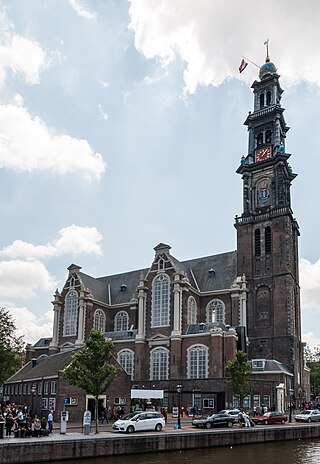
The Westerkerk is a Reformed church within Dutch Protestant Calvinism in central Amsterdam, Netherlands. It lies in the most western part of the Grachtengordel neighborhood, next to the Jordaan, between the Prinsengracht and Keizersgracht.
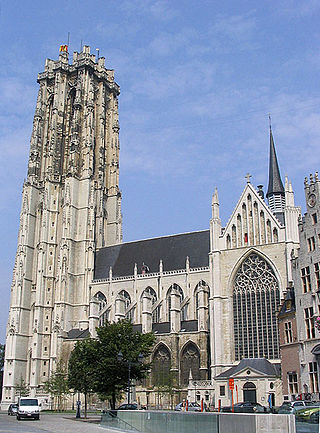
St. Rumbold's Cathedral is the Roman Catholic metropolitan archiepiscopal cathedral in Mechelen, Belgium, dedicated to Saint Rumbold, Christian missionary and martyr who founded an abbey nearby. His remains are rumoured to be buried inside the cathedral. State-of-the-art examination of the relics honoured as Saint Rumbold's and kept in a shrine in the retro-choir, showed a life span of about 40 years and a death date between 580 and 655, while tradition had claimed 775 AD.

The Grote Kerk or St.-Bavokerk is a Reformed Protestant church and former Catholic cathedral located on the central market square in the Dutch city of Haarlem. Another Haarlem church called the Cathedral of Saint Bavo now serves as the main cathedral for the Roman Catholic Diocese of Haarlem-Amsterdam.

The Catholic Cathedral Church of St. John (Sint-Janskathedraal) of 's-Hertogenbosch, North Brabant, is the height of Gothic architecture in the Netherlands. It has an extensive and richly decorated interior, and serves as the cathedral for the bishopric of 's-Hertogenbosch.

The Martinitoren is the tallest church steeple in the city of Groningen, Netherlands, and the bell tower of the Martinikerk.

The bourdon is the heaviest of the bells that belong to a musical instrument, especially a chime or a carillon, and produces its lowest tone.

Pieter Hemony and his brother François Hemony were the greatest bellfounders in the history of the Low Countries. They developed the carillon, in collaboration with Jacob van Eyck, into a full-fledged musical instrument by casting the first tuned carillon in 1644.

The Sint Janskerk in Gouda, the Netherlands, is a large Gothic church, known especially for its stained glass windows, for which it has been placed on the list of the top 100 Dutch monuments.

The Hooglandse Kerk is a Gothic church in Leiden. Its earliest parts date back to the last quarter of the fourteenth century. Most of the current structure dates from the fifteenth century. The brick church was dedicated to St. Pancras and today serves parishioners of the Protestant Church in the Netherlands.
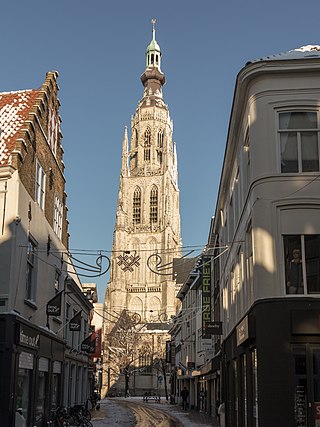
The Grote Kerk or Onze-Lieve-Vrouwekerk is the most important monument and a landmark of Breda. The church is built in the Brabantine Gothic style. The tower of the church is 97 meters tall. The plan is in the shape of a Latin Cross.

Brabantine Gothic, occasionally called Brabantian Gothic, is a significant variant of Gothic architecture that is typical for the Low Countries. It surfaced in the first half of the 14th century at St. Rumbold's Cathedral in the city of Mechelen.
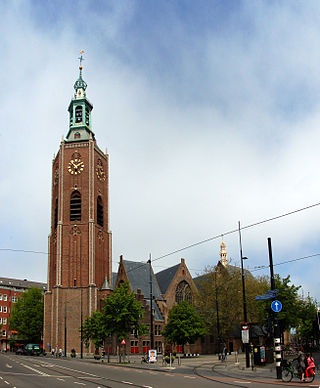
The Great Church or St. James' Church is a landmark Protestant church in The Hague, Netherlands. The building is located on the Torenstraat, named for its high tower. Together with the Binnenhof, it is one of the oldest buildings in The Hague. Members of the House of Orange-Nassau have been baptised and married there. The latest are King Willem-Alexander of the Netherlands and his daughter and heir apparent Catharina-Amalia, Princess of Orange.

Grote or Sint-Laurenskerk is a landmark formerly Protestant church in Alkmaar, Netherlands, now in secular use. The building is located on the Koorstraat. It is mostly closed in the winter and open for tourists in the summer months or by appointment.
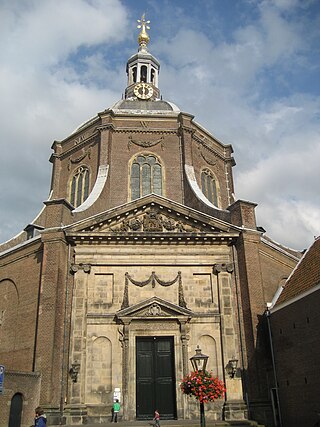
The Marekerk is a Protestant church in Leiden, located at the Lange Mare and the Oude Vest canal. The church can be easily seen from the Oude Vest and the Burcht van Leiden by its round dome.

St Mary's Church, Harrogate is a Grade II* listed redundant parish church in Harrogate, North Yorkshire, England. The successor of the church, which uses the former church hall, is now known as Kairos Church.
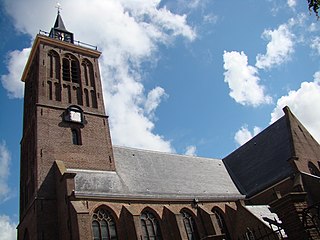
The Grote Kerk is a Protestant church in De Rijp, Netherlands, located near the Town Hall. The church is known for its 17th-century stained-glass windows.

The Waag building is a National monument (Rijksmonument) listed building on the Waagplein in Alkmaar in the Netherlands. On this square Waagplein every Friday from April till the second week of September, the famous cheese market is held. The Dutch Cheese Museum and the tourist information Office (VVV) are also in the building. In the tower is a famous carillon weekly played by a carillonneur and also automatically by a drum chiming the quarters of the hour. There is also the famous automatic horse with knights play in the tower with an automatic trumpetplayer.























